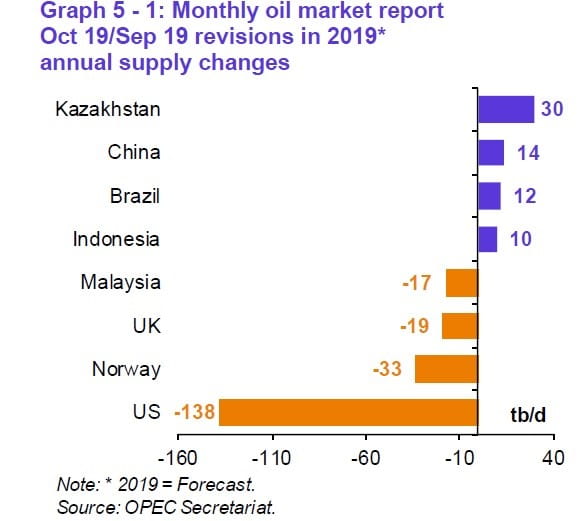As of writing, the US and China are on the verge of signing a limited trade deal that avert the next escalation of tariffs (currently scheduled for next week). Guessing and second-guessing of potential political outcomes aside, Chinese import and export data on Monday will shed some light into how much damage has been done to trade over the last few months.
US imports have been increasingly slipping in importance for Beijing as Russia and Saudi Arabia wrestle for the top two positions, and China has been cutting back on its dependence on US oil ever since trade frictions first started. However, this went a step further at the beginning of September when China started imposing a 5% tariff on US crude imports, and it remains to be seen how this has translated into the number of barrels making it across the Chinese border.
KEY OIL MARKET DATA NEXT WEEK:
|
When |
What |
Why it is important |
|
Mon 03.30 |
China Sept Imports, Exports |
It will show the impact of increased trade tariffs, likely to worsen from August numbers |
|
Tue |
New set of US tariffs on China takes effect |
Tariffs that are already in place on $250 bn of Chinese imports will rise from 25% to 30% |
|
Tue 10.00 |
German ZEW data |
A good indicator of the state of German economy |
|
Wed 07.00 |
September car registration data for UK, Germany, Italy, France |
A good indicator of forthcoming transport related petrol demand in Europe |
|
Wed 15.30 |
US crude oil inventories |
Last week at 2.927m |
|
Wed 15.30 |
EIA weekly refinery utilization |
Last week down week-on-week 0.7% |
|
Thu 13.30 |
US September housing starts |
An indicator of demand from US construction industry, previously at 1.364m |
|
Thu 14.15 |
US September industrial production, manufacturing |
A gauge for industrial oil demand. Industrial production previously up 0.6% MoM, manufacturing -0.5% MoM |
|
Fri 03.00 |
China Q3 GDP |
Last at 6.2% but widely expected to show a decline |
|
Fri 03.00 |
China Sept Industrial Production |
Industrial Production rose in August 4.4% YoY |
|
Fri 20.30 |
CFTC Oil Speculative Net Positions |
Last at 389.300 |
In August China’s exports declined -1% on the year and there is very little reason to expect that the trend did not continue into September. Last month’s data is likely to show a worse decline as the US started collecting an additional 15% in tariffs on $125 billion of Chinese goods from the beginning of the month.
More worryingly, many analysts are now downgrading expectations for Chinese economic growth from 6.2% this year to 5.5% in 2020 which would not bode well for oil bulls.
OPEC BRIEF:
OPEC ministers are beginning to prep for the cartel’s next meeting at the beginning of December in Vienna, and early comments show that they are becoming increasingly concerned about which way global demand is heading. Among the top concerns on their list is the slow but persistent erosion of the Chinese economy –the country’s GDP data due on Friday will shed some light on that – but the oil cartel have recently warned that an overall slowdown in global demand may cause them to opt for bigger cuts in December. OPEC’s World Oil Outlook for next year due to be published on 3 November will show in black and white how much erosion there has been this year in global oil demand.

COUNTRY CORNER: RUSSIA
Although technically not a part of OPEC, Russia has been key to coordinating output cuts with other OPEC countries in order to keep prices up. However, there is mixed motivation for Russia to restrain its oil exports. The country is still under partial sanctions from the US and the bulk of its revenue depends on natural resources. For every $1 increase in the price of oil Russia pockets $7.5 million in daily export revenues of which 75% makes it into the state budget. Russia has a moderate record in sticking to production cuts it has committed to, so while it may agree on paper on future output restrictions this will not necessarily translate into reduced outflows.
As frictions between China and the US escalate, Russia is filling that space with increased exports to China. For the last three to four years it has overtaken Saudi Arabia as the main oil exporter to China and last year it upped its China exports by 40% to 1.658 million barrels a day.




